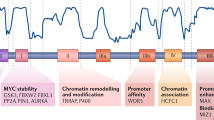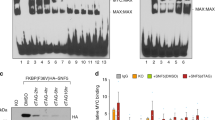Abstract
The c-Myc oncoprotein is a general transcription factor whose target genes dictate the c-Myc phenotype. One such target of c-Myc, ‘onzin’, is normally expressed at high levels in myeloid cells and is dramatically downregulated in response to c-Myc overexpression. We show here that short hairpin interfering RNA-mediated knockdown of endogenous onzin results in a reduced growth rate and a proapoptotic phenotype. In contrast, onzin overexpression in fibroblasts is associated with an increased growth rate, resistance to apoptotic stimuli, loss of the G2/M checkpoint, and tumorigenic conversion. Onzin-overexpressing cells fail to induce p53 in response to apoptotic stimuli and contain higher levels of the active, phosphorylated forms of Akt1 and, more strikingly, of Mdm2. Using yeast two-hybrid and coimmunoprecipitation assays, we show that onzin directly interacts with both proteins. Green fluorescent protein tagging also confirms directly that Akt1 and Mdm2 colocalize with onzin, although the precise subcellular distribution of each protein is dependent on its relative abundance. Collectively, our results identify onzin as a novel regulator of several p53-dependent aspects of the c-Myc phenotype via its dramatic effect on Mdm2. This is reminiscent of the c-Myc → p19ARF--∣ Mdm2 pathway and might function as a complementary arm to ensure the proper cellular response to oncogenic and/or apoptotic stimuli.
This is a preview of subscription content, access via your institution
Access options
Subscribe to this journal
Receive 50 print issues and online access
$259.00 per year
only $5.18 per issue
Buy this article
- Purchase on Springer Link
- Instant access to full article PDF
Prices may be subject to local taxes which are calculated during checkout










Similar content being viewed by others
Accession codes
Change history
17 February 2021
EDITOR’S NOTE: Readers are alerted that in Figure 4B, the control panels appear to be duplicates. As this research was performed many years ago, the authors do not have the original data. However, it does not appear that these duplications affect the overall conclusions of the article.
References
Agarwal ML, Agarwal A, Taylor WR and Stark GR . (1995). Proc. Natl. Acad. Sci. USA, 92, 8493–8497.
Allan LA, Duhig T, Read M and Fried M . (2000). Mol. Cell. Biol., 20, 1291–1298.
Ashcroft M, Ludwig RL, Woods DB, Copeland TD, Weber HO, MacRae EJ and Vousden KH . (2002). Oncogene, 21, 1955–1962.
Ashcroft M and Vousden KH . (1999). Oncogene, 18, 7637–7643.
Bestor TH and Verdine GL . (1994). Curr. Opin. Cell. Biol., 6, 380–389.
Blattner C, Hay T, Meek DW and Lane DP . (2002). Mol. Cell. Biol., 22, 6170–6182.
Boxer LM and Dang CV . (2001). Oncogene, 20, 5595–5610.
Braspenning J, Marchini A, Albarani V, Levy L, Ciccolini F, Cremonesi C, Ralston R, Gissmann L and Tommasino M . (1998). Oncogene, 16, 1085–1089.
Brunet A, Bonni A, Zigmond MJ, Lin MZ, Juo P, Hu LS, Anderson MJ, Arden KC, Blenis J and Greenberg ME . (1999). Cell, 96, 857–868.
Bunz F, Dutriaux A, Lengauer C, Waldman T, Zhou S, Brown JP, Sedivy JM, Kinzler KW and Vogelstein B . (1998). Science, 282, 1497–1501.
Burgering BM and Coffer PJ . (1995). Nature, 376, 599–602.
Chang BD, Xuan Y, Broude EV, Zhu H, Schott B, Fang J and Roninson IB . (1999). Oncogene, 18, 4808–4818.
Chang F, Steelman LS, Lee JT, Shelton JG, Navolanic PM, Blalock WL, Franklin RA and McCubrey JA . (2003). Leukemia, 17, 1263–1293.
Chin L, Pomerantz J and DePinho RA . (1998). Trends Biochem. Sci., 23, 291–296.
Chivers PT, Laboissiere MC and Raines RT . (1996). EMBO J., 15, 2659–2667.
Chivers PT, Prehoda KE and Raines RT . (1997). Biochemistry, 36, 4061–4066.
Collet JF, D'Souza JC, Jakob U and Bardwell JC . (2003). J. Biol. Chem., 278, 45325–45332.
Colman MS, Afshari CA and Barrett JC . (2000). Mutat. Res., 462, 179–188.
Comer FI and Parent CA . (2002). Cell, 109, 541–544.
Cross SM, Sanchez CA, Morgan CA, Schimke MK, Ramel S, Idzerda RL, Raskind WH and Reid BJ . (1995). Science, 267, 1353–1356.
Datta SR, Brunet A and Greenberg ME . (1999). Genes Dev., 13, 2905–2927.
Eischen CM, Weber JD, Roussel MF, Sherr CJ and Cleveland JL . (1999). Genes Dev., 13, 2658–2669.
El-Deiry WS, Harper JW, O'Connor PM, Velculescu VE, Canman CE, Jackman J, Pietenpol JA, Burrell M, Hill DE and Wang Y et al. (1994). Cancer Res., 54, 1169–1174.
Evans JR, Mitchell SA, Spriggs KA, Ostrowski J, Bomsztyk K, Ostarek D and Willis AE . (2003). Oncogene, 22, 8012–8020.
Fernandez PC, Frank SR, Wang L, Schroeder M, Liu S, Greene J and Cocito Aand Amati B . (2003). Genes Dev., 17, 1115–1129.
Fomenko DE and Gladyshev VN . (2003). Biochemistry, 42, 11214–11225.
Freedman DA, Wu L and Levine AJ . (1999). Cell Mol. Life Sci., 55, 96–107.
Ganguli G, Abecassis J and Wasylyk B . (2000). EMBO J., 19, 5135–5147.
Ganguli G and Wasylyk B . (2003). Mol. Cancer Res., 1, 1027–1035.
Green DR . (1997). Science, 278, 1246–1247.
Guo QM, Malek RL, Kim S, Chiao C, He M, Ruffy M, Sanka K, Lee NH, Dang CV and Liu ET . (2000). Proc. Natl. Acad. Sci. USA, 60, 5922–5928.
Haupt Y, Maya R, Kazaz A and Oren M . (1997). Nature, 387, 296–299.
Hendrich B and Bird A . (1998). Mol. Cell. Biol., 18, 6538–6547.
Jacobs JJ, Scheijen B, Voncken JW, Kieboom K, Berns A and van Lohuizen M . (1999). Genes Dev., 13, 2678–2690.
Juin P, Hunt A, Littlewood T, Griffiths B, Swigart LB, Korsmeyer S and Evan G . (2002). Mol. Cell. Biol., 22, 6158–6169.
Kandel ES, Skeen J, Majewski N, Di Cristofano A, Pandolfi PP, Feliciano CS, Gartel A and Hay N . (2002). Mol. Cell. Biol., 22, 7831–7841.
Kaufmann SH . (1998). Biochim. Biophys. Acta, 400, 195–211.
Landay M, Oster SK, Khosravi F, Grove LE, Yin X, Sedivy J, Penn LZ and Prochownik EV . (2000). Cell Death Differ., 7, 697–705.
Langlands K, Yin X, Anand G and Prochownik EV . (1997). J. Biol. Chem., 272, 19785–19793.
Li M, Brooks CL, Wu-Baer F, Chen D, Baer R and Gu W . (2003a). Science, 302, 1972–1975.
Li Z, Van Calcar S, Qu C, Cavenee WK, Zhang MQ and Ren B . (2003b). Proc. Natl. Acad. Sci. USA, 100, 8164–8169.
Liang and Slingerland JM . (2003). Cell Cycle, 2, 339–345.
Ma Q, Alder H, Nelson KK, Chatterjee D, Gu Y, Nakamura T, Canaani E, Croce CM, Siracusa LD and Buchberg AM . (1993). Proc. Natl. Acad. Sci. USA, 90, 6350–6354.
Mayo LD and Donner DB . (2001). Proc. Natl. Acad. Sci. USA, 98, 11560–11598.
Mayo LD and Donner DB . (2002). Trends Biochem. Sci., 27, 462–467.
Momand J, Wu HH and Dasgupta G . (2000). Gene, 242, 15–22.
Moore L, Venkatachalam S, Vogel H, Watt JC, Wu CL, Steinman H, Jones SN and Donehower LA . (2003). Oncogene, 22, 7831–7837.
Mu ZM, Yin XY and Prochownik EV . (2002). J. Biol. Chem., 277, 43175–43184.
Mullan PB, Quinn JE, Gilmore PM, McWilliams S, Andrews H, Gervin C, McCabe N, McKenna S, White P, Song YH, Maheswaran S, Liu E, Haber DA, Johnston PG and Harkin DP . (2001). Oncogene, 20, 6123–6131.
Nesbit CE, Grove LE, Yin X and Prochownik EV . (1998). Cell Growth Differ., 9, 731–741.
Nesbit CE, Tersak JM and Prochownik EV . (1999). Oncogene, 18, 3004–3016.
Nesbit CE, Tersak JM, Grove LE, Drzal A, Choi H and Prochownik EV . (2000). Oncogene, 19, 3200–3212.
Nikiforov MA, Chandriani S, O'Connell B, Petrenko O, Kotenko I, Beavis A, Sedivy JM and Cole M . (2002). Mol. Cell. Biol., 22, 5793–5800.
Ogawara Y, Kishishita S, Obata T, Isazawa Y, Suzuki T, Tanaka K, Masuyama N and Gotoh Y . (2002). J. Biol. Chem., 277, 21843–21850.
O'Keefe K, Li H and Zhang Y . (2003). Mol. Cell. Biol., 23, 6396–6405.
Oren M . (2001–2002). Harvey Lect., 97, 57–82.
Paez J and Sellers WR . (2003). Cancer Treat. Res., 115, 145–167.
Page C, Lin HJ, Jin Y, Castle VP, Nunez G, Huang M and Lin J . (2000). Anticancer Res., 20, 407–416.
Peterson RT and Schreiber SL . (1999). Curr. Biol., 9, 521–524.
Philipp-Staheli J, Kim KH, Liggitt D, Gurley KE, Longton and Kemp CJ . (2004). Oncogene, 23, 905–913.
Pomerantz J, Schreiber-Agus N, Liegeois NJ, Silverman A, Alland L, Chin L, Potes J, Chen K, Orlow I, Lee HW, Cordon-Cardo C and DePinho RA . (1998). Cell, 92, 713–723.
Prendergast GC . (1999). Oncogene, 18, 2967–2987.
Prescott JE, Osthus RC, Lee LA, Lewis BC, Shim H, Barrett JF, Guo Q, Hawkins AL, Griffin CA and Dang CV . (2001). J. Biol. Chem., 276, 48276–48284.
Steinman HA, Burstein E, Lengner C, Gosselin J, Pihan G, Duckett CS and Jones SN . (2004). J. Biol. Chem., 279, 4877–4886.
Testa JR and Bellacosa A . (2001). Proc. Natl. Acad. Sci. USA, 98, 10983–10985.
Vanhaesebroeck B and Alessi DR . (2000). Biochem. J., 346, 561–576.
Vargas DA, Takahashi S and Ronai Z . (2003). Adv. Cancer Res., 89, 1–34.
Voo KS, Carlone DL, Jacobsen BM, Flodin A and Skalnik DG . (2000). Mol. Cell. Biol., 20, 2108–2121.
Vousden KH . (2000). Cell, 103, 691–694.
Wagner AJ, Kokontis JM and Hay N . (1994). Genes Dev., 8, 2817–2830.
Weber JD, Taylor LJ, Roussel MF, Sherr CJ and Bar-Sagi D . (1999). Nat. Cell Biol., 1, 20–26.
Weber JD and Zambetti GP . (2003). Cell Death Differ., 10, 409–412.
West KA, Castillo SS and Dennis PA . (2002). Drug Resist. Update, 5, 234–248.
Willis AE, Paulin FE, West MJ and Whitney RL . (1997). Curr. Top. Microbiol. Immunol., 224, 269–276.
Wood LJ, Maher JF, Bunton TE and Resar LM . (2000). Cancer Res., 60, 4256–4261.
Yang C, Sun M, Illic Z, Friedrich TD and Sell S . (2003). Mol Carcinogen., 36, 15–22.
Yi F, Jaffe R and Prochownik EV . (2003). Cancer Res., 63, 2923–2932.
Yin X, Grove L, Datta NS, Katula K, King MW and Prochownik EV . (2001a). Cancer Res., 61, 6487–6493.
Yin X, Landay MF, Han W, Levitan ES, Watkins SC, Levenson RM, Farkas DL and Prochownik EV . (2001b). Oncogene, 20, 4650–4664.
Yin X, Grove L, Rogulski K and Prochownik EV . (2002). J. Biol. Chem., 277, 19998–20010.
Yin X, Giap C, Lazo JS and Prochownik EV . (2003). Oncogene, 22, 6151–6159.
Zhou BP and Hung MC . (2002). Semin. Oncol., 29, 62–70.
Zindy F, Eischen CM, Randle DH, Kamijo T, Cleveland JL, Sherr CJ and Roussel MF . (1998). Genes Dev., 12, 2424–2433.
Acknowledgements
We are grateful to Nissim Hay, Paul Coffer, and Christine Blattner for supplying plasmids. This work was supported by NIH grant HL33741 (to EVP) and by a post-doctoral fellowship award from The Research Advisory Committee of Children's Hospital of Pittsburgh to YL.
Author information
Authors and Affiliations
Corresponding author
Rights and permissions
About this article
Cite this article
Rogulski, K., Li, Y., Rothermund, K. et al. Onzin, a c-Myc-repressed target, promotes survival and transformation by modulating the Akt–Mdm2–p53 pathway. Oncogene 24, 7524–7541 (2005). https://doi.org/10.1038/sj.onc.1208897
Received:
Revised:
Accepted:
Published:
Issue Date:
DOI: https://doi.org/10.1038/sj.onc.1208897
Keywords
This article is cited by
-
Ontogenetically distinct neutrophils differ in function and transcriptional profile in zebrafish
Nature Communications (2023)
-
MYC: a multipurpose oncogene with prognostic and therapeutic implications in blood malignancies
Journal of Hematology & Oncology (2021)
-
Multifaced roles of PLAC8 in cancer
Biomarker Research (2021)
-
Targeting AKT with costunolide suppresses the growth of colorectal cancer cells and induces apoptosis in vitro and in vivo
Journal of Experimental & Clinical Cancer Research (2021)
-
Platelet-activating factor acetyl hydrolase IB2 dysregulated cell proliferation in ovarian cancer
Cancer Cell International (2021)



